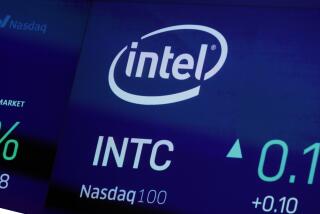Intel to shed flash memory division
- Share via
SAN FRANCISCO — Intel Corp. and STMicroelectronics are unloading troubled divisions that make a type of flash memory used primarily in cellphones.
The chip makers and private equity firm Francisco Partners said Tuesday that they would form a company that would buy the assets of Intel’s and STMicro’s NOR flash businesses.
It promises to placate skittish investors concerned about the fading fortunes of NOR flash memory.
Overall revenue for the chips was $8.3 billion last year, but the entire segment was unable to turn a profit, according to market researcher ISuppli Corp.
The deal signals the waning importance of NOR flash. Invented by Intel in the late 1980s, it has been steadily losing ground to NAND flash memory, a cheaper alternative that’s used in digital cameras and music players.
Until now, Intel, the world’s largest semiconductor company, has stood by the unprofitable business.
The division was losing about $150 million a year before Intel formed a joint venture in 2005 with Micron Technology Inc. to produce NAND flash.
The red ink continued last year, with Intel losing about $555 million from the combined businesses primarily because of start-up costs for the NAND business. Intel no longer reports revenue for NOR flash.
In Tuesday’s deal, Santa Clara, Calif.-based Intel will get $432 million in cash for its NOR flash unit.
Swiss firm STMicroelectronics will sell its entire flash memory operation, including the NOR division and its stake in a joint venture with Hynix Semiconductor Inc. that makes NAND flash chips, for $468 million.
No name has been chosen for the new company, which will combine businesses that generated about $3.6 billion in sales last year.
STMicroelectronics will retain 48.6% equity ownership; Intel will have 45.1%. Francisco Partners will invest $150 million in the venture for preferred stock representing a 6.3% stake.
“It’s good news for ST; it’s good news for Intel -- they’re finally getting out from under it,” said Doug Freedman, an analyst with American Technology Research Inc.
“And it’s probably good news for the industry.”




